If you’re looking to manage anxiety in children, understanding their symptoms is key. Early detection can help prevent long-term issues. Techniques like Cognitive Behavioral Therapy and exposure therapy have proven effective. Engaging parents in the process enhances outcomes and supports emotional growth. It’s essential to create a supportive environment at home and teach coping strategies. By focusing on these aspects, you’re setting a strong foundation for your child’s well-being. Discover more tips and strategies to help your child thrive.
Key Takeaways
- Early recognition of anxiety symptoms in children is crucial for effective intervention and preventing long-term issues.
- Cognitive Behavioral Therapy (CBT) is highly effective in reshaping negative thought patterns and enhancing coping strategies.
- Parental involvement significantly improves treatment outcomes, as parents can model healthy stress management and provide emotional support.
- Establishing consistent routines and open communication fosters a sense of security and helps children express their fears.
- Gradual exposure to anxiety-inducing situations can effectively reduce fear and build resilience in children.
Understanding Anxiety Disorders in Children
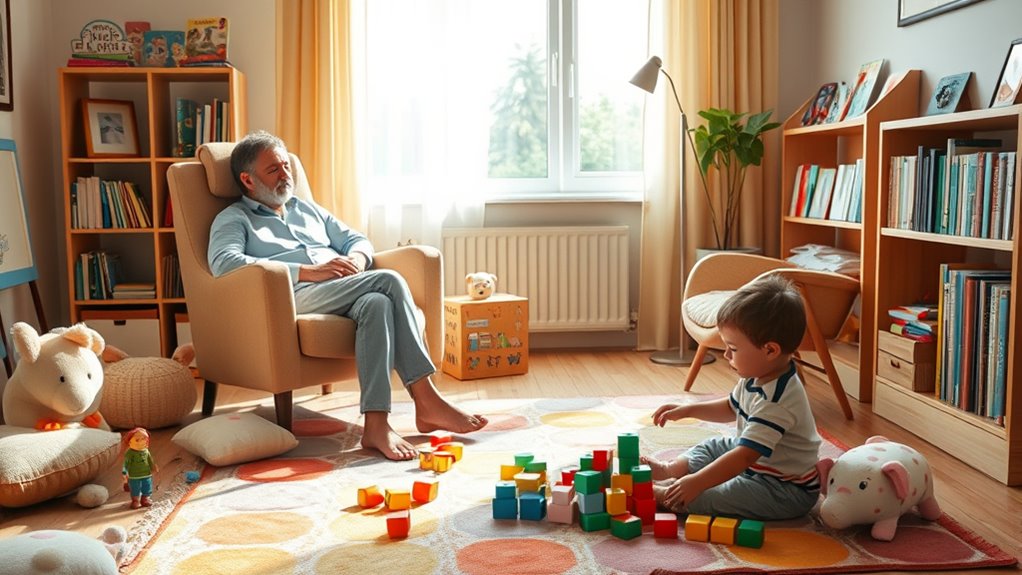
Understanding anxiety disorders in children is crucial, especially since they affect one in eight kids today. These disorders can develop at various ages, with early adolescence being a critical risk phase.
If left untreated, anxiety can lead to ongoing mental health issues and social difficulties that may persist into adulthood. Anxiety disorders are more common than other mental health problems in children, and recent trends show a concerning increase in diagnoses.
Different types include Generalized Anxiety Disorder, Separation Anxiety Disorder, Social Anxiety Disorder, Specific Phobias, and Panic Disorder.
Recognizing these conditions is essential for timely intervention and support, helping children navigate their challenges and promoting healthier futures.
Common Symptoms and Manifestations

When anxiety strikes children, it often manifests in a variety of physical, emotional, and behavioral symptoms that can considerably impact their daily lives.
You might notice physical signs like increased heart rate, sweating, or stomachaches. Emotionally, they may experience excessive worry, fears about safety, or difficulty expressing their feelings.
Behaviorally, children may become irritable, clingy, or avoid certain situations altogether. They might have trouble sleeping, leading to nightmares or even bedwetting.
Daily life can feel overwhelming, causing them to avoid social activities or school. Changes in appetite or a fear of making mistakes can also arise.
Recognizing these symptoms is essential for helping your child navigate their anxiety and improve their overall well-being.
Effective Treatments: Cognitive Behavioral Therapy
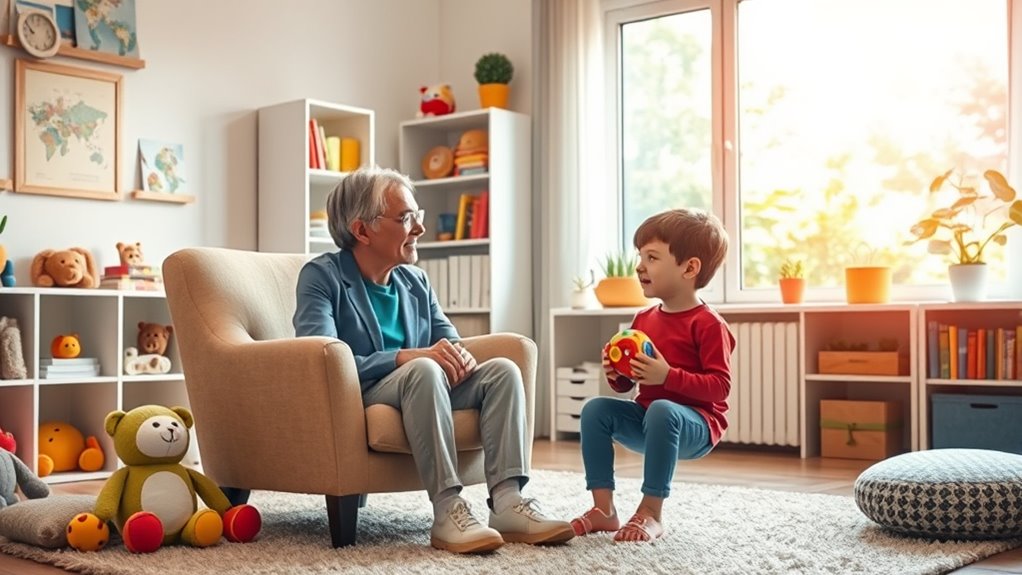
Recognizing the symptoms of anxiety in children is just the first step; finding effective treatments is essential for their well-being.
Cognitive Behavioral Therapy (CBT) is a highly effective approach that helps children identify and reshape distorted thoughts contributing to anxiety. Through cognitive restructuring and behavioral activation, children engage in positive activities, reducing avoidance behaviors.
CBT also equips kids with coping strategies like deep breathing and positive self-talk, fostering resilience. Involving parents enhances support at home, making the process more effective.
With a success rate of about two-thirds, many children experience significant improvement and maintain these gains long-term. While access to trained providers can be challenging, the benefits of CBT make it a valuable option for managing childhood anxiety.
The Role of Exposure Therapy

Exposure therapy plays an essential role in helping children confront their fears in a structured and supportive way. This approach involves gradually facing feared items or situations, allowing kids to learn that these situations aren’t as threatening as they think.
By creating a hierarchy of fears, therapists guarantee that challenges are manageable and increase gradually. Exposure therapy is particularly effective for anxiety disorders like social anxiety and phobias, often requiring fewer sessions than traditional talk therapy.
Children gain confidence and coping skills, helping them face future challenges. This method not only reduces anxiety symptoms but also breaks the cycle of fear and avoidance, making it a powerful tool in managing anxiety in children. Additionally, successful co-parenting can create a supportive environment that fosters emotional stability for children during such transitions.
Importance of Parental Involvement
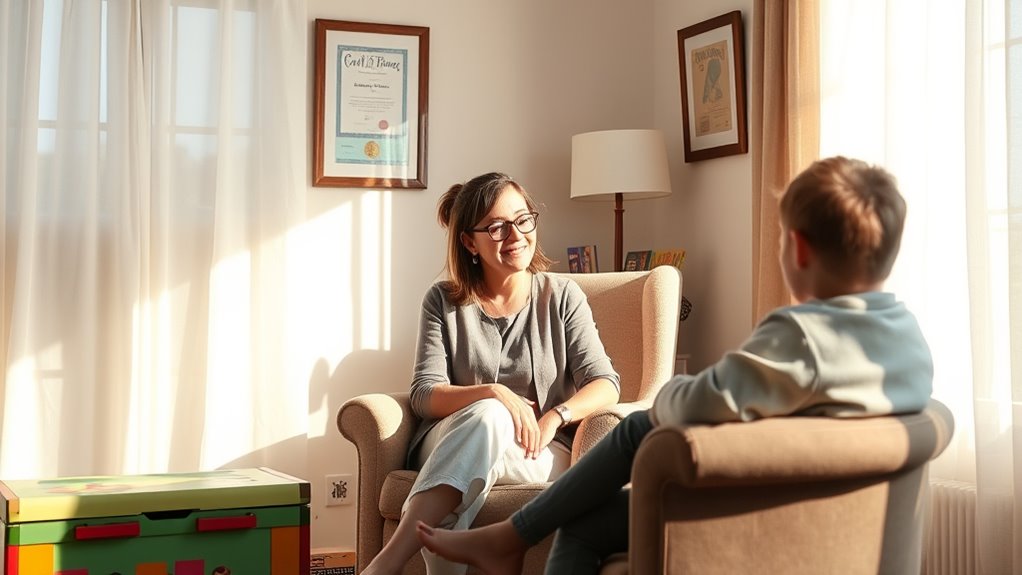
Parental involvement is essential in managing anxiety in children, as it directly influences their emotional well-being and treatment outcomes. When you understand anxiety and participate in therapies like Cognitive Behavioral Therapy (CBT), you help create a supportive environment.
Your own anxiety can impact your child, so addressing it’s vital. Family dynamics matter; unintentional accommodations can increase anxiety levels. Engaging in therapy, even when your child resists, can enhance treatment efficacy.
By modeling healthy stress management, you guide your child’s emotional development. Prioritizing self-care, maintaining open communication with therapists, and joining support groups can empower you and improve outcomes.
Ultimately, your active involvement fosters resilience, helping your child navigate their anxiety more effectively.
Navigating Social Media and Its Impact
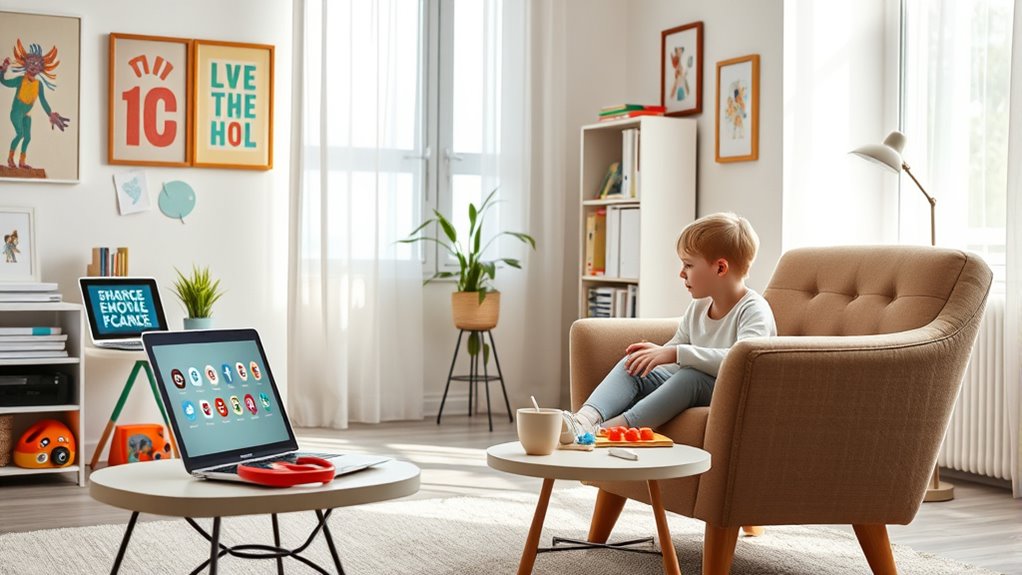
As children navigate their formative years, social media can play a significant role in shaping their emotional landscape. Frequent use, especially beyond two hours daily, increases anxiety risks, while the comparison culture can undermine self-esteem. Additionally, children who experience narcissistic relationships may struggle even more with self-worth in the face of social media pressures. Research indicates that gaslighting tactics can exacerbate these challenges, leading to heightened feelings of confusion and self-doubt.
You’ll notice that hyperconnectivity keeps kids tethered to social pressures, making it hard for them to find a break. This environment can lead to mental health challenges, including depression and anxiety. Establishing budgeting practices for screen time can help children manage their social media usage more effectively.
Adolescents are particularly vulnerable due to ongoing brain development. It’s vital to help your child establish healthy social media habits. Set screen time limits, encourage positive engagement, and discuss the potential risks. Additionally, fostering emotional intelligence can empower children to navigate social media more effectively and enhance their resilience against negativity.
Community Support and Resources
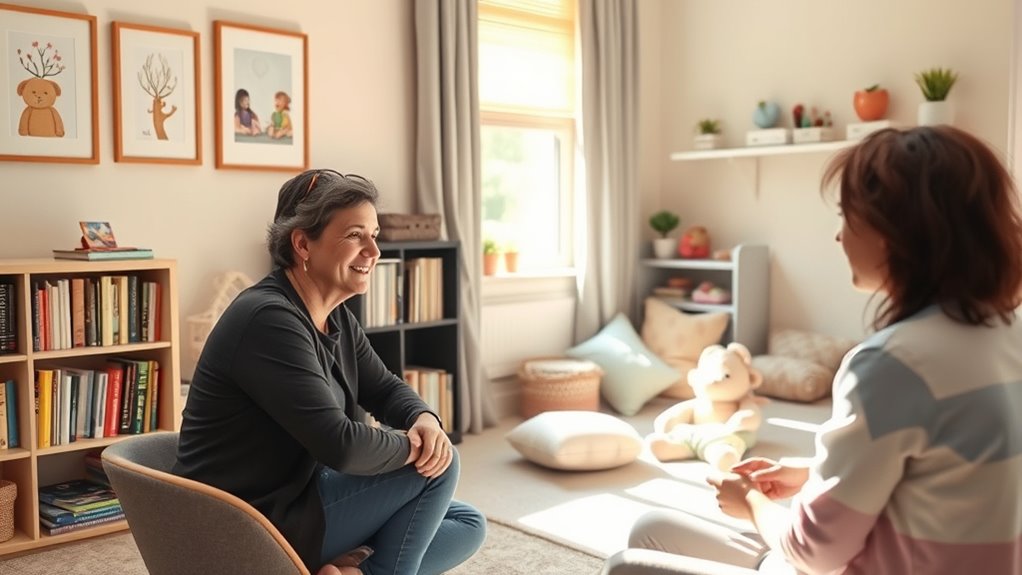
When children face anxiety, community support and resources can make a significant difference in their well-being. Organizations like the Anxiety and Depression Association of America (ADAA) and the National Institute of Mental Health (NIMH) offer valuable information and guidance on managing anxiety disorders.
The Child Mind Institute provides strategies through cognitive-behavioral approaches, while the National Alliance on Mental Illness (NAMI) supports families in steering through these challenges. Additionally, parents should consider the importance of effective co-parenting communication to ensure children feel secure and supported during times of anxiety. Establishing structured routines can also help children feel more stable and reduce anxiety levels.
You can also explore educational resources like “What to Do When You Worry Too Much” and online courses tailored for children. Involving licensed therapists, especially those trained in cognitive behavioral therapy, is vital. Additionally, understanding the stages of grief can help parents recognize and address anxiety that may arise from loss or change in a child’s life.
Community and school support, along with social networks, play an essential role in fostering emotional stability for anxious children.
Tips for Parents to Manage Children’s Anxiety
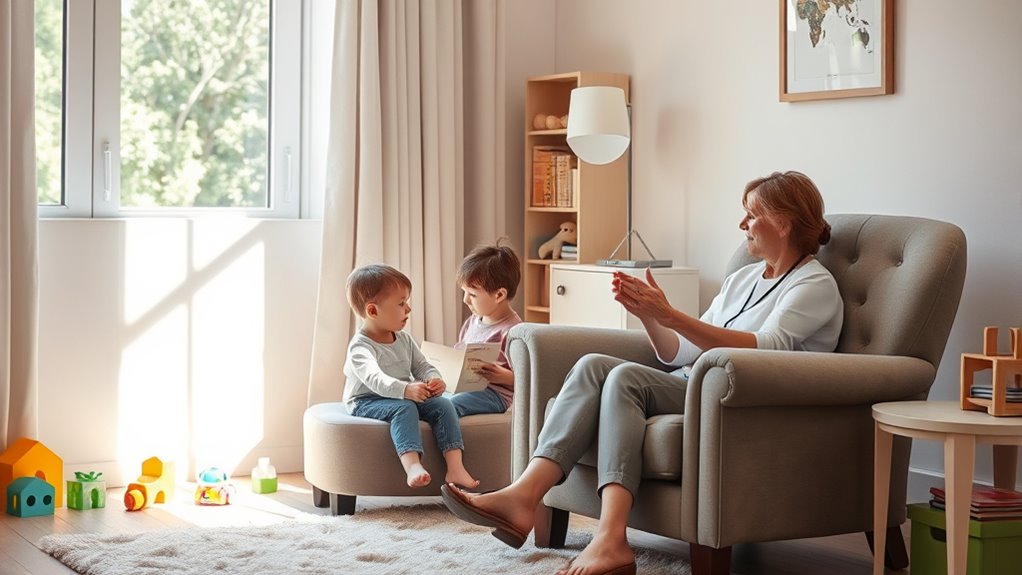
Community support and resources provide a foundation for managing children’s anxiety, but parents play a crucial role in this journey.
Start by identifying triggers that cause your child anxiety, and validate their feelings without minimizing their experiences. Stay calm during anxious moments to model healthy coping.
Identify your child’s anxiety triggers, validate their feelings, and model calmness to foster healthy coping mechanisms.
Establish consistent routines to offer reassurance and encourage open communication; ask open-ended questions to help them express their emotions. Teach recognition of anxiety signs and coping strategies like deep breathing.
Gradually expose them to fears, and break overwhelming tasks into manageable steps. Set realistic expectations, express confidence in their abilities, and celebrate small achievements. Additionally, ensure your child has access to proper nutrition as it can significantly impact their emotional well-being and resilience against anxiety.
Frequently Asked Questions
How Can I Tell if My Child’s Anxiety Is Serious?
To tell if your child’s anxiety is serious, watch for symptoms like excessive worrying, physical complaints, or avoidance of certain situations.
If they’re frequently irritable or have trouble sleeping, these could be warning signs.
Notice if they’re overly clingy or withdrawing from social interactions, as well.
It’s essential to seek professional help if these behaviors interfere with their daily life.
Trust your instincts; you know your child best.
What Should I Do if My Child Refuses Therapy?
If your child refuses therapy, it’s important to understand their perspective.
Imagine a door to a room filled with support, but your child feels scared to enter. Start by discussing their feelings openly and reassuringly. Frame therapy as a chance for them to gain tools for coping.
Encourage them to try a few sessions without pressure. Remember, maintaining a supportive relationship is key, allowing them to feel safe and heard as they navigate this decision.
Are There Specific Medications for Children’s Anxiety?
Yes, there are specific medications for children’s anxiety. SSRIs like Zoloft and Prozac are commonly prescribed as first-line treatments.
SNRIs, such as Effexor XR, can also be used, though they’re less common due to side effects.
For short-term relief, benzodiazepines like Ativan may help.
It’s essential to consult a healthcare professional to determine the best approach for your child, considering their unique needs and any potential side effects.
How Can Teachers Support Anxious Children in School?
Imagine a child feeling like they’re trapped in a storm of worries. As a teacher, you can be their anchor.
Create a safe environment where they can express feelings, and use calming aids like fidget toys. Establish predictable routines and design quiet spaces for them to retreat.
Regular check-ins and teaching coping strategies like deep breathing can empower them. Building trust through supportive relationships helps them feel secure, allowing their confidence to grow.
What Are the Long-Term Effects of Untreated Anxiety in Children?
Untreated anxiety in children can lead to significant long-term effects.
You might notice that they struggle with academic performance and social interactions, which can persist into adulthood. This anxiety can increase the risk of developing depression and lead to substance abuse as a coping mechanism.
Physical health issues, such as headaches and sleep problems, often arise too. Overall, untreated anxiety can hinder their development and impact their quality of life.
Conclusion
Managing anxiety in children isn’t just about understanding their fears; it’s about empowering them to face those fears. It’s about engaging with their emotions, encouraging open communication, and fostering resilience. By actively participating in their journey, you can nurture their confidence and help them develop coping strategies. Remember, seeking support, whether through therapy or community resources, is not a sign of weakness but a step toward strength. Together, you can create a foundation for a brighter, calmer future.









